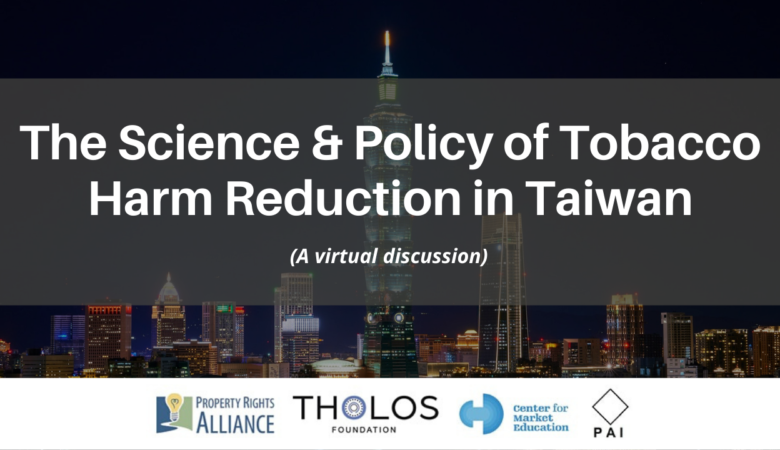PRA Webinar Shows Growing International Consensus on Tobacco Harm Reduction
Last week Property Rights Alliance, Tholos Foundation, the Center for Market Education, and Pacific Alliance Institute hosted a virtual policy conference entitled “The Science & Policy of Tobacco Harm Reduction in Taiwan.”
Taiwan’s Cabinet earlier this year initiated a legislative amendment to ban e-cigarettes and certain flavored tobacco products based on flawed analysis. The amendment does contain some positive aspects for harm reduction as well, such as allowing a legal pathway for heat-not-burn products. At PRA’s webinar, ten experts on the scientific and political aspects of tobacco harm reduction found areas of consensus on key strategies to help improve public health and societal outcomes in Taiwan and around the world.
The relative safety of vaping products compared to cigarettes has been shown repeatedly. As explained at the webinar by Dr. Colin Mehdehlson, Founding Chairman of the Australian Tobacco Harm Reduction Association, nicotine vaping products like e-cigarettes have been shown to be the most effective quitting aid for smokers and are at least 95% safer than smoking combustible cigarettes. He therefore emphasized that the goal was “replacing high-risk combustible products” with “lower-risk non-combustible alternatives.” Clive Bates, Creator of Counterfactual Consulting and Former Director of Action on Smoking & Health, concurred and argued that any precautionary policy which restricts accessibility to e-cigarettes can ultimately “cause harm by perpetuating smoking.”
Professor Tzu-Hsuen Yuan from the Department of Health & Welfare at the College of City Management at the University of Taipei later concurred with this idea in reference to the Taiwanese experience, recommending that reduced-harm non-combustible products be less restricted than combustible products in order to ensure that people who continue to consume nicotine products avoid the most risks to their health.
One concern in countries around the world that has served as an impetus for higher restrictions on vaping products is a worrying trend of youth vaping rates. However, as shown by Professor Brad Rodu, Endowed Chair for Brown Cancer Center’s Tobacco Harm Reduction Wing at the University of Louisville, in the United States vaping rates have actually fallen among high school students in the previous two years, while smoking rates have almost disappeared completely. He further showed that frequent vapers who did not previously smoke represent just 3% of American high school students, which, while still too high, is far lower than the commonly quoted statistics for youth vaping and far lower than the rates of more dangerous underage activities such as drinking alcohol (30%) or carrying a weapon (16%).
The public health situation among Taiwanese youth appears to be more dire based on the continued prevalence of the more dangerous combustible tobacco products. Professor Kai-Jen Chuang, Professor of Public Health at Taipei Medical University, noted that despite the specific vilification of vaping products in Taiwan, use of traditional combustible cigarettes still outnumbers the use of noncombustible products among Taiwanese youth. Professor Yuan also indicated that the majority of smokers in Taiwan had their first experience with tobacco products prior to age 18, arguing that tobacco and nicotine policies should be crafted with particular demographic groups in mind to best address health outcomes across the population.
The outcomes of such policies are also deeply influenced by economic factors, as described by several experts at the webinar. Dr. Carmelo Ferlito, CEO of the Center for Market Education, explained the issue of tobacco harm-reduction from the perspective of economic theory, noting that consumers make calculated decisions that compare their pleasure from a product with the total costs of that product and showing that bans or higher taxes on tobacco products often serve to boost the black market. Michelle Minton, Senior Fellow at the Competitive Enterprise Institute, echoed Dr. Ferlito by explaining that bans on tobacco products “do not and in fact cannot eliminate demand or markets” for those products. Rather, bans shift demand from legal markets into illicit markets, which tends to lead to even greater harm for consumers than the existence of legal tobacco products.
Professor Chee-Ruey Hsieh, Health Economist and Adjunct Professor at Feng Chia University, added to the economic understanding of tobacco harm reduction policies by explaining that as taxes on tobacco products increase, not only does smuggling increase but costs are also regressively imposed on low-income consumers the most harshly.
These experiences with tobacco harm reduction have been repeated in countries around the world and particularly in the Indo-Pacific region. Yuya Watase, Chairman of the Pacific Alliance Institute and a researcher at Waseda University, presented a video from PAI which recommends the “Harm Reduction Lifestyle,” a comprehensive strategy in Japan for improving public health and driving innovation. Louis Houlbrooke, Campaigns Manager for New Zealand Taxpayers Union, also presented on experiences in New Zealand where heated tobacco and vaping products became legal relatively recently. As a result, since 2018, vaping rates in New Zealand doubled while smoking rates fell by almost a third, resulting in reduced harm for consumers overall. More information on the New Zealander experience with tobacco harm reduction, as well as the experience in several other countries, was published last year in the PRA report “Vaping Works.”
Ultimately, according to Professor Chuang, the Taiwanese government has not produced enough evidence to justify its proposal to ban e-cigarettes when combustible products continue to be the primary threat to health. Professor Hsieh agreed that the current legislative proposal is not based on the evidence, concluding that such tobacco and nicotine policies “should focus on helping smokers to quit instead of pushing smokers into the corner.”
Experts at this policy conference across the fields of medicine, economics, and policy came to similar key conclusions: pro-innovation policies are important for reducing the harm of tobacco products, noncombustible products such as e-cigarettes are far less harmful than combustible cigarettes, and ensuring access to these reduced-harm products is one of the best strategies for achieving optimal public health outcomes without inadvertent negative repercussions.
You can watch the full webinar here.

